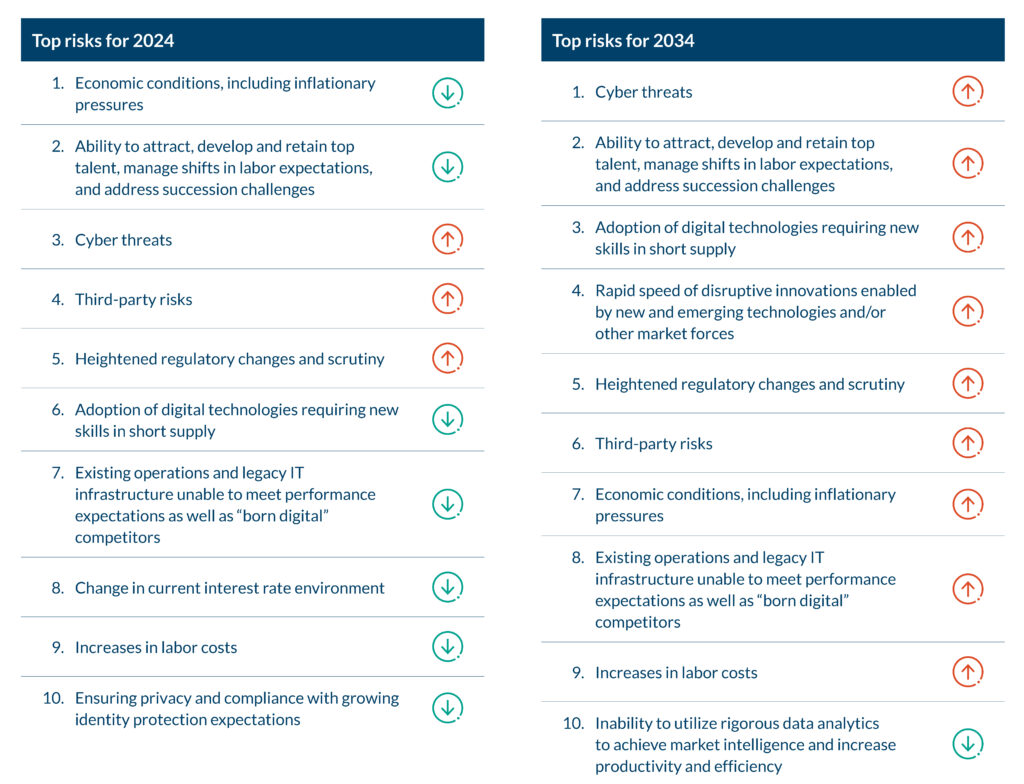The churn in this year’s Top Risks Survey results points to multiple sources of uncertainty, painting a cloudy, interconnected picture of the business landscape.
Economic pressures and persistent inflation have unseated the war for talent as the top near-term risk facing business leaders around the world, according to the latest Executive Perspectives on Top Risks Survey from Protiviti and NC State University’s ERM Initiative.
This global study, conducted annually, measures the most pressing business risks over the next year as well as the next decade, into 2034. The table below summarizes the top 10 risks for 2024 and 2034.
The combined analysis of risk insights from global executives for both 2024 and a decade out reveals several interrelated challenges that may test an organization’s business agility and resilience. Here are just some of the highlights and key takeaways from our research:
- Multiple sources of uncertainty create potential for a wide range of near-term horizon risks. The shift in top risks from last year reveals a global business environment experiencing significant change, with many new risk concerns for 2024 relative to last year.
- Recent geopolitical developments are changing the risk landscape. Prior to the October 7, 2023, developments in the Middle East, no risks were rated at the “Significant Impact” level for 2024; however, after the attacks, many risks increased, with four rated at the “Significant Impact” level.
- Economic concerns zoom to the top risk position near term. Economic conditions, particularly inflationary pressures, replaced the ability to attract, develop and retain top talent, manage shifts in labor expectations, and address succession challenges as the number one risk globally for 2024.
- Myriad technology-related challenges include escalated cybersecurity risks, continued data privacy concerns linked to increased third-party reliance, the need to upskill employees to realize fully the value proposition of emerging technologies, and the limitations of legacy infrastructure. These technology-linked risks are interrelated and need to be considered collectively by executives and the board, as exposures triggered by one risk may lead to increased exposure to other risks. The rapid speed of technology and disruptive innovations enabled by advanced technologies or other market forces is impacting business models and customer experiences. Advancing tech is impacting cybersecurity by expanding the attack surface available to bad actors. Legacy IT systems and existing operations may make it difficult for incumbents to compete with nimbler “born digital” competitors. Executives are also focusing on the challenge of addressing proliferating identity protection expectations.
- People-related risks intertwine the top near-term and long-term risks. Executives continue to focus on risks related to finding and retaining the right kind of talent for their organization’s strategic success. Executives are particularly focused on challenges associated with attracting unique kinds of talent and upskilling existing employees, which will allow their organizations to embrace emerging digital technologies.
- Regulatory changes and scrutiny are heightened for the near term and a decade out. The potential for expansion in rules and regulatory oversight are creating increased concerns not only for 2024, but also 2034 given it represents the top five risk for both the near-term and long-term horizons.
- Disruptive innovations and the inability to utilize rigorous data analytics are creating significant pause for executives as they think about their organization’s long-term competitive positioning. Continued advances in artificial intelligence and other technologies are driving a wave of disruption that will impact business models, sweep away obsolete strategies and alter customer experiences.
A call to action: The ever-changing risk landscape and the overall perceived magnitude and severity of risks should prompt boards and senior executives to scrutinize closely the approaches they use to remain focused on emerging risk issues and to integrate those insights into strategic decision-making. Now may be an opportune time for boards and C-suites to examine closely where to invest not only to preserve market image and branding but also foster a strong recovery when the economy bounces back and prospects for growth improve.
Our report, Executive Perspectives on Top Risks for 2024 and a Decade Later, includes detailed results and analysis by role, industry, organization size and type, and geographic region, as well as several calls to action that executives may want to consider as they evaluate the effectiveness of their organization’s risk governance processes. We also provide a comprehensive list of diagnostic questions executives and directors may find helpful to consider when evaluating their risk assessment and risk management processes.
The executive summary, full report, infographic, podcast and other resources are available for complimentary download here. Protiviti is hosting a complimentary one-hour webinar on January 11, 2024, at 8 a.m. PST/11 a.m. EST, to discuss the survey findings. Register for the webinar here.






